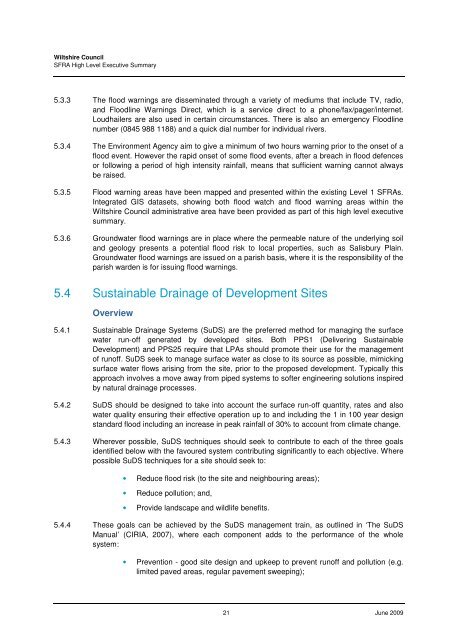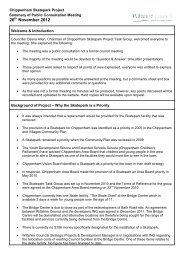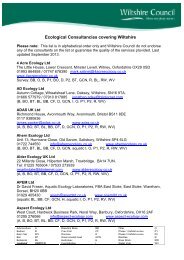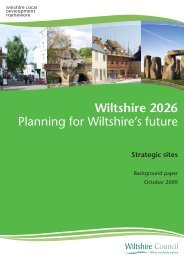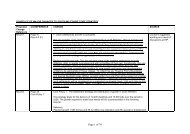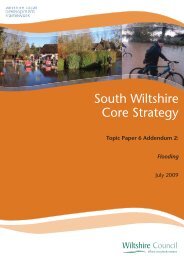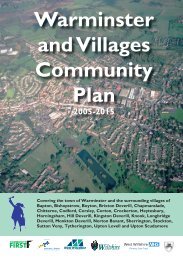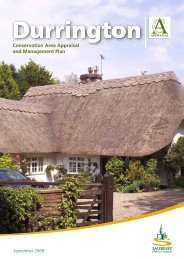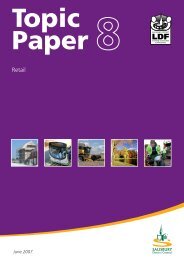Strategic Flood Risk Assessment - Wiltshire Council
Strategic Flood Risk Assessment - Wiltshire Council
Strategic Flood Risk Assessment - Wiltshire Council
You also want an ePaper? Increase the reach of your titles
YUMPU automatically turns print PDFs into web optimized ePapers that Google loves.
<strong>Wiltshire</strong> <strong>Council</strong>SFRA High Level Executive Summary5.3.3 The flood warnings are disseminated through a variety of mediums that include TV, radio,and <strong>Flood</strong>line Warnings Direct, which is a service direct to a phone/fax/pager/internet.Loudhailers are also used in certain circumstances. There is also an emergency <strong>Flood</strong>linenumber (0845 988 1188) and a quick dial number for individual rivers.5.3.4 The Environment Agency aim to give a minimum of two hours warning prior to the onset of aflood event. However the rapid onset of some flood events, after a breach in flood defencesor following a period of high intensity rainfall, means that sufficient warning cannot alwaysbe raised.5.3.5 <strong>Flood</strong> warning areas have been mapped and presented within the existing Level 1 SFRAs.Integrated GIS datasets, showing both flood watch and flood warning areas within the<strong>Wiltshire</strong> <strong>Council</strong> administrative area have been provided as part of this high level executivesummary.5.3.6 Groundwater flood warnings are in place where the permeable nature of the underlying soiland geology presents a potential flood risk to local properties, such as Salisbury Plain.Groundwater flood warnings are issued on a parish basis, where it is the responsibility of theparish warden is for issuing flood warnings.5.4 Sustainable Drainage of Development SitesOverview5.4.1 Sustainable Drainage Systems (SuDS) are the preferred method for managing the surfacewater run-off generated by developed sites. Both PPS1 (Delivering SustainableDevelopment) and PPS25 require that LPAs should promote their use for the managementof runoff. SuDS seek to manage surface water as close to its source as possible, mimickingsurface water flows arising from the site, prior to the proposed development. Typically thisapproach involves a move away from piped systems to softer engineering solutions inspiredby natural drainage processes.5.4.2 SuDS should be designed to take into account the surface run-off quantity, rates and alsowater quality ensuring their effective operation up to and including the 1 in 100 year designstandard flood including an increase in peak rainfall of 30% to account from climate change.5.4.3 Wherever possible, SuDS techniques should seek to contribute to each of the three goalsidentified below with the favoured system contributing significantly to each objective. Wherepossible SuDS techniques for a site should seek to:• Reduce flood risk (to the site and neighbouring areas);• Reduce pollution; and,• Provide landscape and wildlife benefits.5.4.4 These goals can be achieved by the SuDS management train, as outlined in ‘The SuDSManual’ (CIRIA, 2007), where each component adds to the performance of the wholesystem:• Prevention - good site design and upkeep to prevent runoff and pollution (e.g.limited paved areas, regular pavement sweeping);21 June 2009


